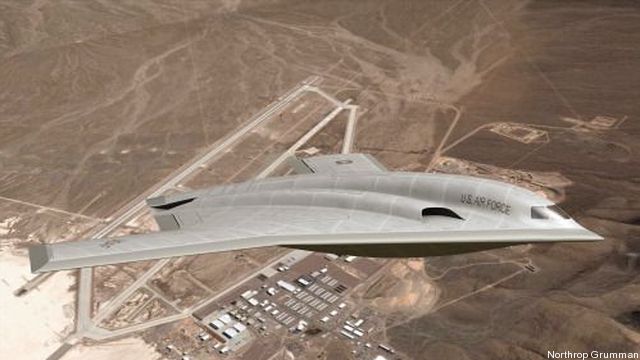
President Obama is sending his proposed $585 billion 2016 Pentagon budget to Capitol Hill on Monday. It consists of reams of documents, charts and tables that make it difficult for normal folks to understand. So let’s take a look at a single line item—the Air Force’s new bomber, for which the service is expected to seek about $1.5 billion next year—for insight into why Pentagon numbers don’t always add up.
The new bomber—designed to augment, and ultimately replace, the nation’s aging fleets of B-52, B-1 and B-2 aircraft—is so new that it doesn’t even have a name yet, beyond the generic title Long Range Strike Bomber.
But the highly-classified warplane already has a well-publicized price.
The cost, the Pentagon has been saying since 2011, is $550 million per bomber. It’s the only price tag attached to the new bomber and, and a result, it’s the one cited when the new plane is discussed.
“It’s like $550 million per copy,” Rear Admiral John Kirby, the Pentagon spokesman, said earlier this month. “It’s an estimate based upon multiple reviews of the program and not a single source.”
“Five hundred million dollars per copy sounds like a lot of money, but for the capability that we will be achieving, it actually is considered to be affordable,” Air Force Secretary Deborah Lee James told Bloomberg last summer.
A team of Boeing and Lockheed Martin is competing against Northrop Grumman to build the Air Force’s next crown jewel. Northrop produced the nation’s newest bomber, the B-2, and hinted at its desire to build the Long Range Strike Bomber during Sunday’s Super Bowl, when it aired a 30-second spot in Washington, D.C., and Dayton, Ohio, home of the Air Force’s acquisition corps.
The $550 million figure has been cited so often that those not playing close attention could be forgiven for thinking that it’s the actual cost of the airplane. Kind of like the bottom line on the sticker you see on the window of a new car. But it’s not. Like any bureaucracy dedicated to expansion, the $550 million sum is the lowest figure the Air Force number can say with a straight face.
After repeatedly planting that $550 million flag in the minds of lawmakers and taxpayers, Pentagon officials have sometimes acknowledged that the $550 million represents what is known inside the military as the “APUC,” or average procurement unit cost. What’s important about that figure isn’t what it includes, but what it leaves out.
First of all, the $550 million price tag is based on buying between 80 and 100 of the bombers. Driving the price per plane down to $550 million requires economies of scale that only come over such long production runs. Early aircraft off the assembly line are very expensive, as the radar-eluding B-2 “stealth” bomber made clear. “Cost of Stealth Bombers Soars to $450 Million Each,” the Washington Post reported breathlessly on its front page nearly 30 years ago, in May 1988. Few believed at the time that a bomber could cost so much. But that was for a planned buy of 132 planes. The Air Force ended up buying only 21. The B-2’s ultimate price: $2.1 billion each.
Second, the $550 million doesn’t include the research and development needed to actually build the plane. Without the R&D, the plane would truly be stealthy—because it wouldn’t exist. Experts inside and outside the Pentagon estimate the new bomber’s development will add between $20 billion and $25 billion to the Pentagon’s projected $55 billion procurement price tag for 100 planes.
Third, the $550 million price is based on the value of a 2010 dollar. That’s 12 years before the first pair of bombers is slated to be delivered. Accounting for inflation since has already driven the cost per plane close to $600 million, and that number will keep rising in the future. Delays in the plane’s production schedule will push it even higher.
Finally, the $550 million estimate doesn’t include anything for the all-but-certain cost overruns a weapons program like this will experience. No one can say how much unanticipated costs will add to the bomber’s ultimate price, but one can declare with certainty that it won’t be zero.
Todd Harrison of the independent Center for Strategic and Budgetary Assessments think tank estimates the bomber program’s true cost—assuming 100 planes and no cost overruns—at $90 billion. That’s $900 million a copy, 64% higher than the Air Force’s official $550 million figure.
“I actually think it’s very important that we buy the bomber,” Harrison says. “I just think we should acknowledge what it is likely to cost.” He also thinks there will be cost overruns, and that fewer than 100 will be bought. That’ll drive the price per plane into the B-2’s billion-dollar stratosphere.
Harrison isn’t the only one with doubts, judging from what some Air Force officials have said while describing the new bomber’s advertised price. Eric Fanning, the Air Force’s #2 civilian, has called the $550 million figure “a pretty firm chalk line.” Chief Air Force weapons buyer William LaPlante describes it a “marker in the sand.”
Whatever. It’s obvious that the Air Force’s $550 million estimate isn’t carved in stone.
More Must-Reads from TIME
- Cybersecurity Experts Are Sounding the Alarm on DOGE
- Meet the 2025 Women of the Year
- The Harsh Truth About Disability Inclusion
- Why Do More Young Adults Have Cancer?
- Colman Domingo Leads With Radical Love
- How to Get Better at Doing Things Alone
- Michelle Zauner Stares Down the Darkness
Contact us at letters@time.com